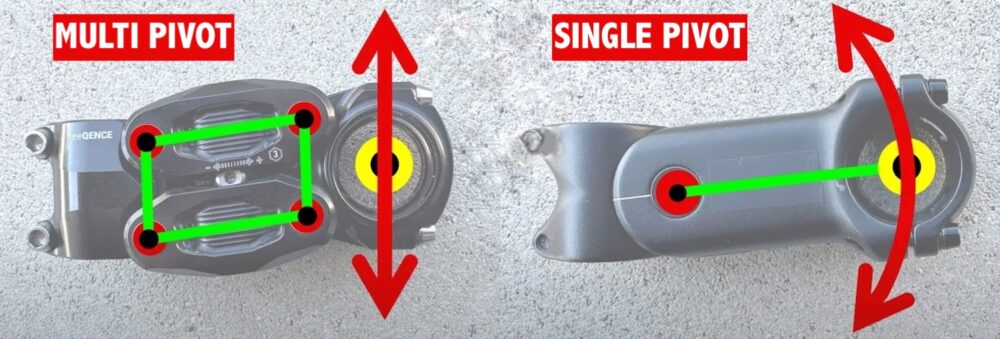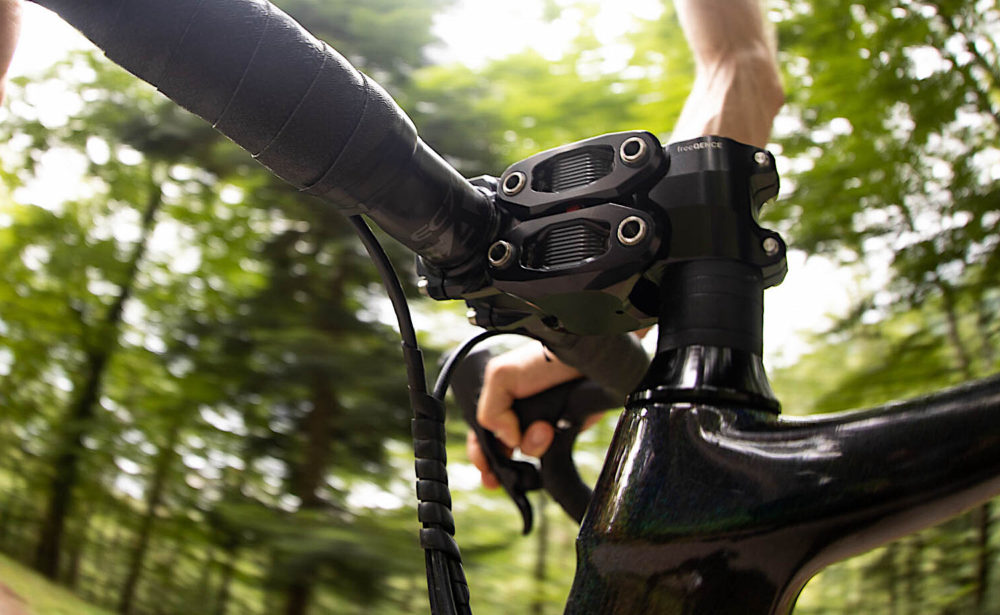Table of Contents
Suspension stems like the Vecnum Freeqence are nothing new.
Several companies developed suspension stems for mountain biking in the early-1990s. The most notable models were the Softride Stem and the Girvin Flexstem, which were even used on bikes that won multiple mountain bike world championships!
However, by the mid-1990s, suspension stems were superseded by superior-performing suspension forks.
These days, suspension stems are primarily designed to increase the comfort of a rigid bike. They have significantly less suspension travel than previously (usually just 20mm), and they are stiffer, lighter, and much more reliable.
I got my hands on one of the latest suspension stems to test, a model called the Vecnum Freeqence. While this stem might not be a well-known product, I think it should be known by every gravel rider in the world!
In this review, you’ll find out why…
What is the Vecnum Freeqence Suspension Stem?
Linkage: Multi Pivot
Spring Type: Elastomer
Length: 90 to 120mm
Min Weight: 287 g / 10.1 oz
Travel: 30mm / 1.2″
Bar Clamp: 31.8mm
The Vecnum Freeqence is the most expensive suspension stem on the market right now – it’s €299 or US $325. But you get a surprising amount for your money.
To start, this German-made product makes extensive use of high-quality 7075 aluminium, as well as titanium for the hollow axles. This keeps the weight within 100 grams (3.5 oz) of most rigid stems, and it’s about 200 grams (7 oz) lighter than comparable suspension stems.
The stem’s suspension travel is uniquely divided into 20 mm of downward travel and 10 mm of upper travel, for a total of 30 mm. This not only prevents ‘top out’ but keeps your hands nicely suspended in the air over bumpy terrain.
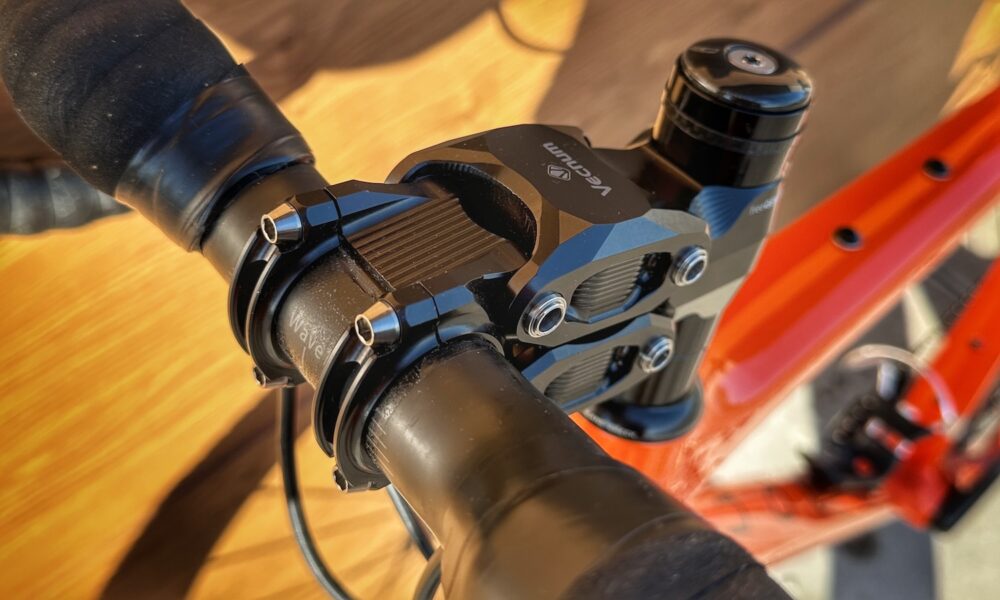
The Freeqence employs elastomer springs that offer a strong progression. This allows the stem to be noticeably supple in the first part of its travel, and much firmer when it is deeper in its suspension travel.
Vecnum designed this stem for riders between 50 and 120 kg (110-265 lb). Interestingly, there is only one spring rate, but you can adjust the spring preload by tightening the screw on the side of the stem (3 mm Allen key). This firms up the initial portion of the suspension travel for heavier and/or more aggressive riders. In more technical terms, the spring won’t start compressing until the force on the stem is more than the preload force.
In terms of aesthetics, the Freeqence has a unique look. My 7-year-old son says it looks like a sci-fi machine, and I can’t say I disagree.
The components inside the stem are nicely protected from dirt and mud, which should translate into long, trouble-free usage. It’s available in three lengths (90, 105, and 120 mm), for standard 1 1/8″ steerers and 31.8 mm handlebars – all with a 3-degree rise.
Vecnum says that the Freeqence can effectively reduce impacts and vibrations by up to 75%. I didn’t record this kind of improvement, but there are improvements over both rigid stems and other suspension stems – keep reading to see my vibration test results.
The Multi Pivot Stem Design
One of the defining features of the Vecnum Freeqence is its multi pivot design.
A multi pivot stem keeps your upper body suspended with the same spring rate, no matter where you place your hands on a drop bar. This ultimately means you can achieve a decent comfort improvement with your hands in the brake hoods, on the bar tops, or in the drops.
A multi pivot stem is also suitable for flat bars, and sweptback bars as it doesn’t matter where your hands are relative to the pivot points.

In comparison, a single pivot stem (like the Redshift ShockStop) works most effectively in the brake hoods, less effectively on the bar tops, and is almost ineffective in the drops. This is because when your hands are in the drops, there is little leverage forward of the pivot point.
Single pivot stems are largely ineffective with flat or sweptback bars as your hands usually end up too close to the pivot point.
In addition, the suspension travel changes depending on where you place your hands. For example, if your hands are 50mm in front of the pivot point, rather than 100mm – you will only get half the suspension travel.
Lastly, a single pivot stem also experiences some slight forward tilting of the handlebar when it compresses, as it travels on an arc rather than a straight line. This is not too much of a hindrance, but it is noticeable.
To see a video explanation of multi pivot vs single pivot stems, watch Alee’s video HERE.
How Does It Feel On Gravel Roads?
In one word, GREAT! The Freeqence gave me additional confidence in my rigid gravel bike to go faster and down rougher trails.
The stem feels smooth on fast gravel roads, and it absorbs bigger hits (like square-edged rocks and roots) with ease. Thanks to the upward and downward stem travel, your hands feel adequately suspended in the air.
This suspension stem has more material damping than you’d expect from a stem with elastomer springs. This results in significantly less rapid vertical movement than other stems – it almost feels as if there is a hydraulic damper hidden inside. The stem doesn’t ever feel too bouncy’ either; overall, it feels very measured.
But it’s not without its flaws.
Are There Any Downsides?
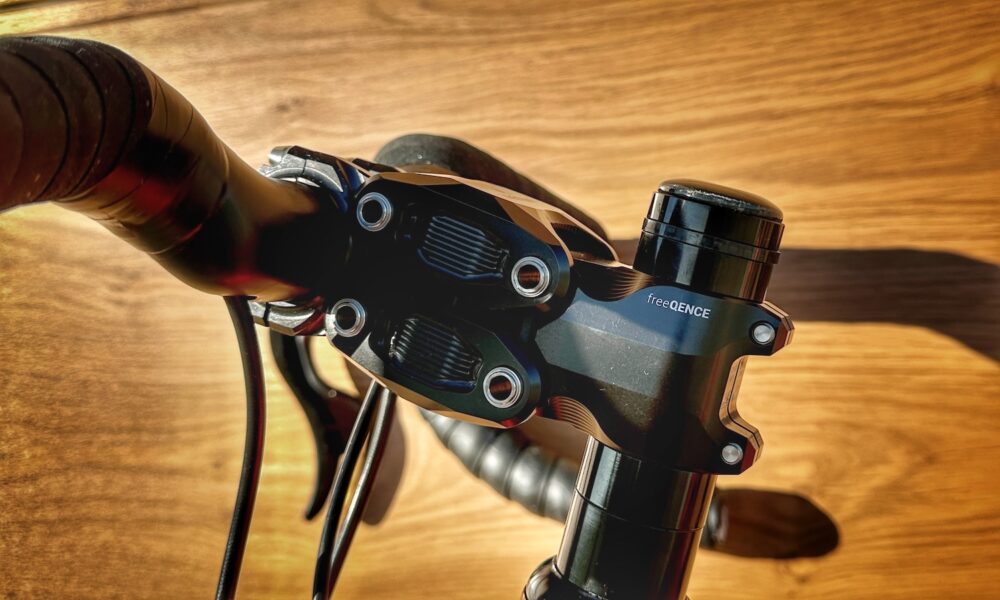
There’s a noticeable bobbling effect when pedalling hard uphill. Given the short range of motion, I can’t say it’s that big or disturbing, but you will notice it.
You can also notice the 10mm of upward stem travel, especially when rapidly pulling up on the handlebar on technical terrain. Again, it won’t bother you much, but your bike might feel less connected to the ground below.
If you’re coming from a rigid stem, you may also need to learn to trust your bike’s steering again, as the steering is a little different when your handlebars bounce a bit while cornering. It’s a quick adjustment, but something to keep in mind.
In addition, Alee noted in his article, Why Suspension Stems Are The Ultimate Comfort Upgrade that the Freeqence has less torsional stiffness compared to other stems he’s tested. I didn’t notice any lack of stiffness with my 420mm wide drop bars, but given Alee uses 700mm+ wide flat bars, he is exerting quite a lot more leverage on his Freeqence stem. That’s something to keep in mind if you are planning to pair this stem with a wide flat handlebar.
Let’s find out how the Vecnum Freeqence does in my vibration tests.
My Test Bike and Vibration Measurement Procedure
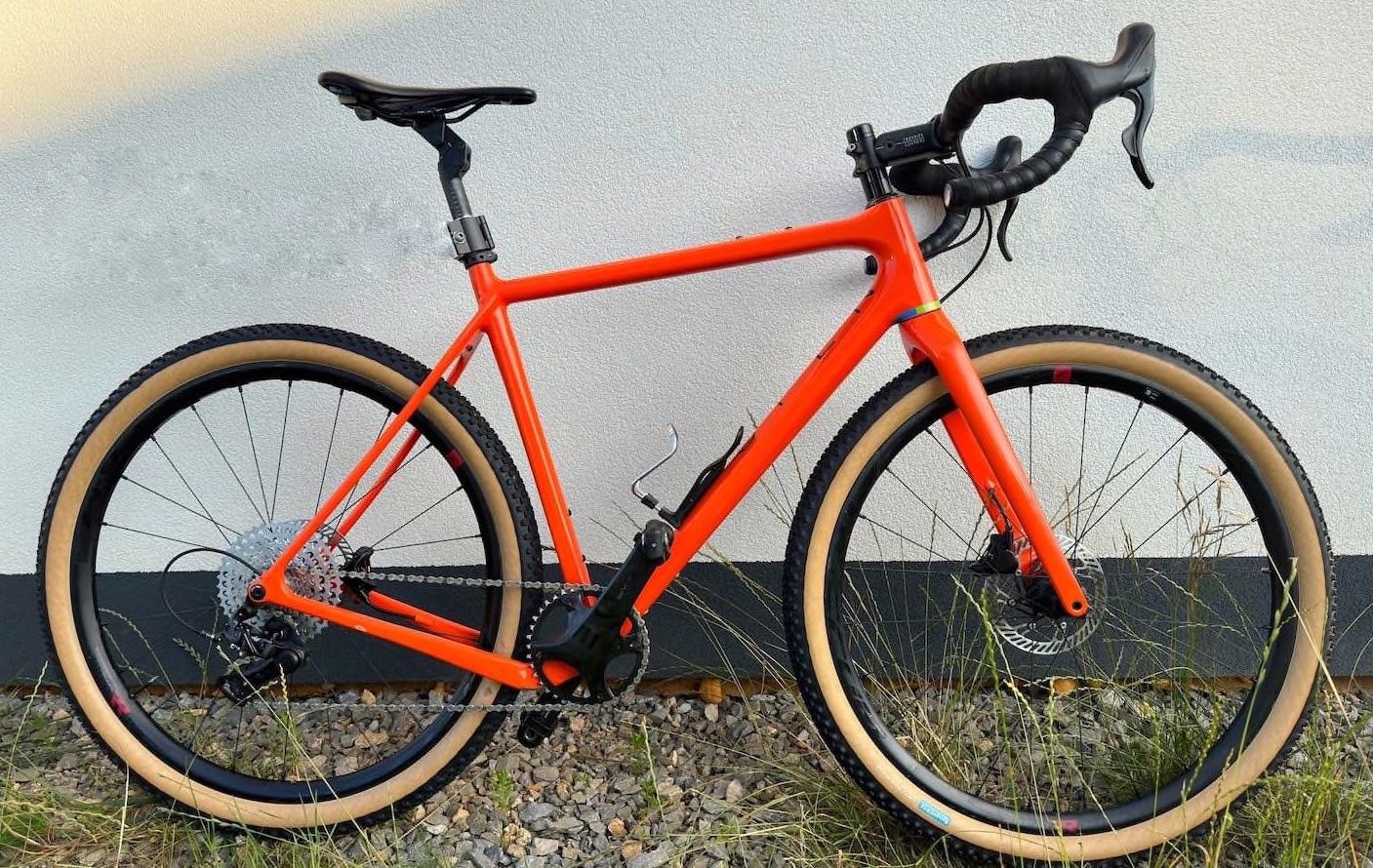
I conducted this vibration test on my Open WI.DE gravel bike fitted with Rene Herse Umtanum Ridge 650B x 55 mm tires at 35 psi (2.5 bar). The Vecnum Freeqence (105 mm length) was compared against a Redshift ShockStop stem (100 mm) and an aluminium rigid stem (100mm). The spring rate of the suspension stems was adjusted to my body weight and preferred riding style.
You can read more about my benchmark bike HERE.
I have two test scenarios: a big hit test that simulates riding across a 30 mm tall obstacle like a tree root or edgy rock, and a high-frequency chatter test that simulates riding on a bumpy gravel road.
You can read more about my vibration measurement procedure HERE.
Vibration Test Results
Big Hit Test

| Average Acceleration (g) | Vibrations When Compared to the Rigid Stem | |
| Rigid Stem (100mm) | 3.5 | – |
| Vecnum Freeqence (105mm) | 3.1 | 11.5% Less Vibration |
| Redshift ShockStop (100mm) | 4.2 | 20% More Vibration |
In the big hit test, the Freeqence performed better than other stems – I recorded 11.5% less vibration at the handlebar compared to the rigid stem.
Part of the reason why the Freeqence performed well is that it offers a slower compression and rebound speed than the Redshift. This helps to effectively remove unwanted vibrations at the handlebar.
Remember, how this stem has 10mm of upward suspension travel in addition to its 20mm of downward travel? That feature also helped keep the vibrations in check as the stem could travel upward slightly after the hard compression.
You might be wondering what happened to the Redshift stem, as it recorded 20% more vibration than the rigid stem. This obstacle induced a large amount of vibration, and the stem simply bounced up and down more than typical because the elastomers didn’t have enough material damping to mitigate it.
From my perspective, this poor result didn’t translate to a less comfortable ride. While the handlebar moved more with the Redshift stem, it subjectively felt more comfortable over the obstacle than the rigid stem.
High-Frequency Chatter Test
| Average Acceleration (g) | Vibrations Compared to Rigid Stem | |
| Rigid Stem (100mm) | 2.7 | – |
| Vecnum Freeqence (105mm) | 2.5 | 9.7% Less Vibration |
| Redshift ShockStop (100mm) | 2.5 | 9.7% Less Vibration |
In the high-frequency chatter test, the Vecnum and Redshift stems were neck and neck. They both reduced the vibration at the handlebar by 9.7% when compared to a rigid stem.
This is an interesting result because both the Vecnum and Redshift stems felt more than 9.7% more comfortable than the rigid stem. This just goes to show that the products I test cannot be represented by a single number!
I also tested the Freeqence’s vibration levels in the stiffest and softest stem settings on both of my obstacles. The differences were surprisingly minimal, which makes sense, as these obstacles generate high forces that would easily exceed the spring preload force, and make the stem quite active.
Vecnum Freeqence vs. Redshift ShockStop vs. Kinekt Suspension Stem



I’ve now tested the three most common suspension stems available, so which is best?
When deciding which stem is best for you, you should consider:
– Your handlebar type (flat or drop bar)
– Your riding position (low or upright)
– Your riding style (sporty or relaxed)
The Redshift ShockStop is the lightest, stiffest, and most tuneable suspension stem design. You’ll instantly notice its ability to reduce the jarring impact of a bigger impact – for example, a pothole in the road. The elastomer springs suit both sporty and relaxed riding styles, and provide a fast but calm suspension feel. The simple, single pivot design is most suitable for drop bar bikes, less suitable for flat bar bikes, and unsuitable for bikes with sweptback handlebars. A key feature of this stem is its sleek aesthetic – it looks just like a regular stem, blending in well on any bike.
You can read my full review of the Redshift stem HERE.
If your bike is more upright, and you ride at a more relaxed pace, you might prefer the Kinekt Suspension stem. This coil spring stem offers the quickest, most responsive movement, which allows it to smooth out high-frequency chatter better than all other stems. With its multi pivot design, it can provide a smooth, floating feel for all handlebar types, and is available in very tall-rise designs.
You can read my full review of the Kinekt stem HERE.
The Vecnum Freeqence is the middle ground between the Redshift and Kinekt. It’s the most sophisticated-feeling stem I’ve tested, with no top out, easy spring firmness adjustment, and a nicely damped ride that isn’t ever too bouncy. This stem is significantly lighter than the Kinekt Suspension stem (287 g vs. 470 g in a 90 mm length), and it’s only slightly heavier than the Redshift ShockStop stem (266g in 90 mm).
The multi pivot design of the Freeqence offers the same comfort improvement, no matter where you place your hands on the handlebars, and the stem suits all handlebar types, all riding positions, and all riding styles.
Summary
The Vecnum Freeqence is the best suspension stem I’ve tested. It works effectively, is easy to adjust, and is great for all handlebar types.
PROS
1. Effective at reducing shock & vibration
2. Excellent feel; never too bouncy
3. The design is ideal for all bar types
4. Very lightweight
CONS
1. Some bobbing when pedalling hard
1. It’s expensive
2. It isn’t as sleek as other stems
4. The torsional stiffness could be improved
The Vecnum Freeqence was unveiled in late 2021, but despite the passage of time, it’s still a relatively unknown product.
This is a pity because the Freeqence delivers the same level of performance as the Redshift ShockStop in my high-frequency chatter test, and does even better in my big hit test. These real-world measurements were backed up by a subjective improvement in comfort too.
The Freeqence has a refined feel that isn’t ever too bouncy, and it’s super quick and easy to adjust the firmness of the elastomer springs.
I love that this stem employs a multi pivot design as it allows me to unlock the full suspension comfort, no matter whether I’m riding in the hoods, drops, or bar tops. It’s ideal for those using flat and sweptback handlebars too.
I’ve found that suspension stems instantly improve your riding experience on a gravel bike, and the Vecnum Freeqence is a standout in terms of what’s available. As a result, I plan to use the Freeqence on my benchmark bike for the foreseeable future.


